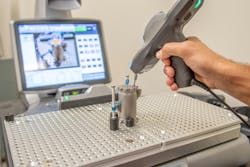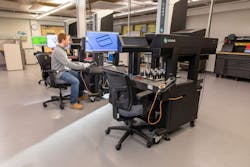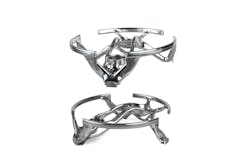Generative Design, Artificial Intelligence and Manufacturing
Maybe you believe generative design and artificial intelligence (AI) are years away—nothing to think about. If so, you’re not alone.
In Protolabs’ recently released report, Product Development Outlook 2024, we aimed to learn more about the things people who rely on our manufacturing services think are important and what they think the future holds for the industry. The report revealed that roughly two-thirds of all those surveyed believe that these advanced capabilities will have little or no effect on their workflows over the next five years
The results seem contrary to how we are seeing AI discussed in public channels. While ChatGPT, Google Gemini and others are increasingly used as resources, it is understandable why incorporating AI into well-established product development processes is complicated because it challenges well-established workflows.
But we are beginning to see the technology’s impact, offering a potential roadmap for the future.
A More Intelligent Design Process
You may not use AI when designing, but you might be surprised to hear that your manufacturer does. Once you submit your CAD, your model is in an environment that may very well be AI-informed. For example, our digital thread for injection-molded parts handles almost every aspect of production but really shines when it comes to design-for-manufacturability (DFM) analysis of CAD files, along with providing quality reports and controls.
READ MORE: How Generative AI is Improving Information Retrieval for Engineers
Each part enters a digital twin of the manufacturing process, producing DFM feedback in just hours instead of days with an assist from AI. Furthermore, the process of scientific molding—wherein each part offers learnings that can be applied in the future—is essentially AI in action.
The result is a faster iteration process, fueling quick turnarounds for product developers rapidly responding to consumer demands or clearing regulatory hurdles.
Additionally, 3D printing is an excellent process to develop novel parts using AI because of its nearly limitless design flexibility. Input the parameters needed and let the computing powers have at it. The system already knows the limitations of each type of 3D printing technology and—informed by that—can apply those learnings to DFM advice.
Quick Definitions: AI and Generative Design
AI involves using computer systems to perform tasks that have historically been done by people. It can speed manufacturing times and can even learn from the problem-solving it does. Generative design is a form of AI that takes its specialized design knowledge and merges it with parameters you input to create designs to meet your specifications.
The fascinating aspect of generative design is that because it can go beyond the inherent biases humans have when designing, sometimes it can come up with CAD models that meet all specifications, but are designed in a totally unexpected way—yielding increased strength and lightweight parts. As with all design, it’s an iterative process to get you what you need. There are a number of open-source programs that can provide a starting point.
Daring to Try Something New
We’re already working with companies who use this new tech. Recently, NASA has been working with generative design to quickly iterate functional parts with the aim to “build more, analyze less.”
To showcase their use of generative design in a hypothetical situation, NASA ran an experiment at the recent PowerSource Global Summit to crowdsource the requirements and design constraints for a tool that could capture vapors from the extreme cold of the moon’s surface (−315°F to −55°F). One morning, attendees at a conference worked for one hour to determine those specs, which were ultimately input into a generative design program.
What the computer came up with was unlike anything they had thought up on their own while encompassing the required characteristics for NASA’s Artemis program, which soon will explore the moon.
In the end, the one-hour session produced 31 design iterations before NASA finalized a CAD file and immediately uploaded the 3D model to Protolabs.com for CNC machining. The process illustrated the power of generative design compared to its traditional dependence on human engineers. Parts were delivered from Protolabs to the conference within 36 hours of design upload, allowing crowdsourcing participants to see the results of their work as part of this experiment. The combination of manufacturing AI and generative design proved a success.
|
|
Design Time |
# of Design Iterations |
|
Human Engineers |
2 days |
4 |
|
Generative Design/AI |
1 hour |
31 |
This is what people mean when they talk about the accelerated pace of digital transformation.
Future Shock
The NASA experience illustrates how AI and generative design are the next step in rapid iteration, creating stronger, lighter parts to minimize loads and ensure that parts can survive in extreme environments. NASA’s work advocates for a new pathway that other companies can take to speed up their development.
The combination of generative design and manufacturing AI isn’t just the future, it’s happening now for those confident enough to turn one small step into one giant leap.
About the Author

Chris Gottlieb
Team Leader, CNC Product Management
Chris Gottlieb brings more than 25 years of manufacturing experience to Protolabs with knowledge in multiple industries, including automation and automotive. Having started as a calibration engineer in Detroit, Gottlieb has a passion for systems engineering and optimization in technical fields. She brings a customer needs perspective to the Protolabs organization while leading the CNC product management team.

Ryan Kees
Product Director, 3D printing
Joining Protolabs in 2023, Ryan Kees brings 13 years of experience in manufacturing and the industrial automation industry. His career spans roles in supply chain, marketing and product management across U.S. and European markets. As the product director of 3D printing at Protolabs, Kees keeps a customer-first perspective in finding ways to advance additive solutions into mainstream manufacturing.



